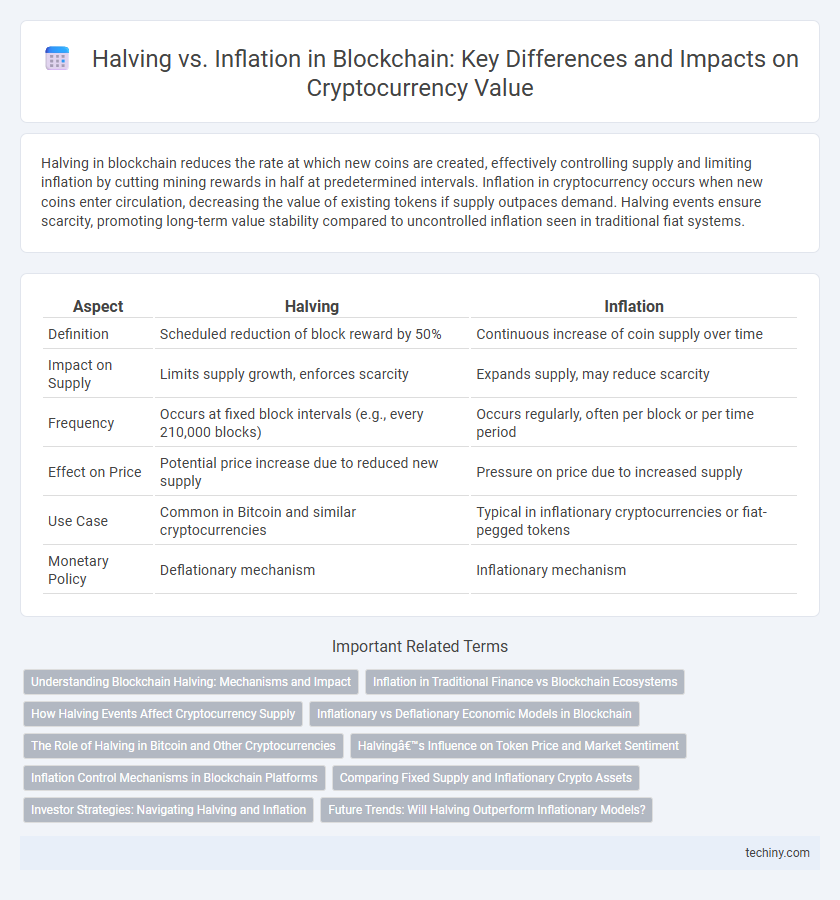Halving in blockchain reduces the rate at which new coins are created, effectively controlling supply and limiting inflation by cutting mining rewards in half at predetermined intervals. Inflation in cryptocurrency occurs when new coins enter circulation, decreasing the value of existing tokens if supply outpaces demand. Halving events ensure scarcity, promoting long-term value stability compared to uncontrolled inflation seen in traditional fiat systems.
Table of Comparison
| Aspect | Halving | Inflation |
|---|---|---|
| Definition | Scheduled reduction of block reward by 50% | Continuous increase of coin supply over time |
| Impact on Supply | Limits supply growth, enforces scarcity | Expands supply, may reduce scarcity |
| Frequency | Occurs at fixed block intervals (e.g., every 210,000 blocks) | Occurs regularly, often per block or per time period |
| Effect on Price | Potential price increase due to reduced new supply | Pressure on price due to increased supply |
| Use Case | Common in Bitcoin and similar cryptocurrencies | Typical in inflationary cryptocurrencies or fiat-pegged tokens |
| Monetary Policy | Deflationary mechanism | Inflationary mechanism |
Understanding Blockchain Halving: Mechanisms and Impact
Blockchain halving is a programmed event that reduces the mining rewards by 50%, directly impacting the rate at which new cryptocurrency tokens enter circulation. This mechanism helps control inflation by limiting supply expansion, preserving scarcity, and potentially increasing the asset's value over time. Understanding halving cycles is crucial for investors and miners as it influences network security, mining profitability, and long-term token economics.
Inflation in Traditional Finance vs Blockchain Ecosystems
Inflation in traditional finance erodes currency value through increased money supply driven by central banks, often leading to reduced purchasing power and economic instability. Blockchain ecosystems counter inflationary pressures with fixed or algorithmically controlled token supplies, such as Bitcoin's halving events that systematically reduce miner rewards, preserving scarcity and value over time. This deflationary mechanism contrasts sharply with fiat systems, fostering trust and long-term asset appreciation within decentralized networks.
How Halving Events Affect Cryptocurrency Supply
Halving events in blockchain reduce the block rewards for miners by 50%, directly limiting the rate at which new cryptocurrency coins are introduced into circulation. This reduction in supply issuance decreases inflationary pressure, often leading to increased scarcity and potential price appreciation. The controlled supply mechanism embedded in protocols like Bitcoin ensures predictable inflation rates, contrasting with traditional fiat currencies subject to unpredictable monetary expansion.
Inflationary vs Deflationary Economic Models in Blockchain
Inflationary economic models in blockchain increase token supply over time, reducing scarcity and potentially lowering value, as seen in projects like Ethereum with continuous issuance. Deflationary models, such as Bitcoin's halving mechanism, cut the rate of new token creation, enhancing scarcity and potentially driving value appreciation by limiting supply growth. Understanding the balance between halving events and inflation rates is crucial for assessing a blockchain's long-term economic sustainability and investment appeal.
The Role of Halving in Bitcoin and Other Cryptocurrencies
Halving significantly reduces the rate at which new bitcoins are created, effectively controlling supply and mitigating inflationary pressures within the Bitcoin network. This programmed scarcity mechanism occurs approximately every four years, halving block rewards miners receive, which helps preserve the asset's value over time. Many other cryptocurrencies implement similar halving schedules or deflationary models to maintain scarcity and incentivize long-term holding among users and investors.
Halving’s Influence on Token Price and Market Sentiment
Halving events in blockchain networks, particularly Bitcoin, reduce the block reward by 50%, directly decreasing the influx of new tokens and limiting supply growth. This scarcity effect often leads to increased market demand, positively influencing token prices as investors anticipate reduced inflation and enhanced value retention. Market sentiment typically turns bullish around halving periods due to expectations of tighter supply dynamics and potential price appreciation.
Inflation Control Mechanisms in Blockchain Platforms
Blockchain platforms implement inflation control mechanisms such as halving events, which reduce the block reward by half at predetermined intervals, effectively slowing the issuance rate of new tokens and combating inflation. These deflationary protocols ensure the scarcity of digital assets like Bitcoin by limiting supply over time, contrasting with traditional fiat currency systems that often experience unchecked inflation. Other mechanisms include capped supply models and adjustable algorithmic monetary policies, which collectively maintain token value stability and promote long-term economic sustainability within decentralized networks.
Comparing Fixed Supply and Inflationary Crypto Assets
Halving events in blockchain reduce the issuance rate of fixed supply assets like Bitcoin, enhancing scarcity and potentially increasing value over time. In contrast, inflationary crypto assets continuously introduce new tokens, diluting supply but supporting network incentives and liquidity. Comparing fixed supply to inflationary models highlights trade-offs between long-term scarcity-driven value appreciation and flexible monetary policies fostering ongoing ecosystem growth.
Investor Strategies: Navigating Halving and Inflation
Investors navigating blockchain markets prioritize strategies that balance the effects of Bitcoin halving events and inflationary pressures on asset value. Halving reduces block rewards, tightening supply and often increasing price, while inflation erodes purchasing power, necessitating diversified portfolios including stablecoins and inflation-resistant assets. Tactical timing around halving cycles combined with hedging against fiat inflation can enhance long-term returns in volatile crypto environments.
Future Trends: Will Halving Outperform Inflationary Models?
Halving events in blockchain reduce the issuance rate of new tokens, directly impacting the supply and potentially increasing scarcity-driven value. Inflationary models, which increase token supply continuously, may face downward pressure on price due to dilution. Future trends suggest that halving mechanisms could outperform inflationary models by enhancing scarcity and incentivizing long-term holding, especially in deflationary crypto ecosystems like Bitcoin.
Halving vs Inflation Infographic

 techiny.com
techiny.com